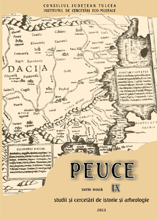Despre magistraţii monetari şi cronologia monetăriilor greceşti dobrogene în perioada preromană
About the monetary magistrates and the chronology of the Greek Dobrujan mints during the pre-Roman period
Author(s): Gabriel Mircea TalmaţchiSubject(s): Archaeology
Published by: Institutul de Cercetari Eco-Muzeale Tulcea - Institutul de Istorie si Arheologie
Keywords: Dobrudja; Pre-Roman period; mints; Dobrogea; perioadă preromană; monetării
Summary/Abstract: As the author’s studies regarding mostly the monetary aspects specific to the Pontic territory during the pre-Roman period aimed a variety of research directions, he now intends to present some partially conclusions, for this stage of the analysis, about the presence of the monetary magistrates on the mentioned coins and the chronology of some monetary types locally cast and coined. A very interesting aspect regarding the activity of the Dobrudjan west Pontic mints, Histria, Callatis and Tomis is represented by the presence of the magistrates names in a short or abbreviated form on the monetary documents. This method began to be practiced beginning with the 4th century BC, by recording some simple initial letters or the abbreviated forms of these magistrates names. Thus, by the presence of the name of the state or the issuing city, there was offered a guarantee, on one hand, and, on the other hand, there was honoured the person who was directly responsible for issuing coins, from the point of view of quantity and quality. The author notices many elements worth putting into the light for specialists (in the case of the three mints).This way, there can be noticed, for example the presence of many coin types issued by the same monetary magistrate. We mention the multitude of acronyms, monograms and other abbreviations used in mints (Histria, Callatis and Tomis) on the coins reverse, but mostly on those from Callatis. Maybe a reason for this situation is the function period of this workshop, meaning the Hellenistic age, rich from this point of view in other regions, as well. The possibility that in a rather limited chronologically period, of about 250 years, to have been issued the majority of the autonomous types, from Callatis, can be the explanation for seeing many times probably the same abbreviation of the monetary magistrate. The monetary magistrates from Tomis are present on coins in a significant number, as also in Callatis, only that the Milesian city issued coin almost a century later on than the Megarian one. Looking down a list including the correspondences of the monetary magistrates, we think there is to be noticed a synchronisation of some coin types, for a longer or shorter period. Is it possible to be synchronous issues, when there existed large and small coins, meaning divisionary, during the same monetary magistrate? The same aspect could be justified among different coin types, but with the same monetary magistrate and which could be issued in the same period, as we have seen for the types The Great God and Demeter, Dioscuri and the Great God (small module) or Hermes. There can be noticed here, as well as in Callatis the possibility to issue a monetary type during a longer period, chronologically speaking, being issued many series, with syncope, according to the local necessities of the city market. And probably the Great God type (the small module) is the best piece of evidence in that aspect. It is certain, that, there also ....
Journal: Peuce (Serie Nouă) - Studii şi cercetari de istorie şi arheologie
- Issue Year: IX/2011
- Issue No: 9
- Page Range: 483-500
- Page Count: 18
- Language: Romanian

